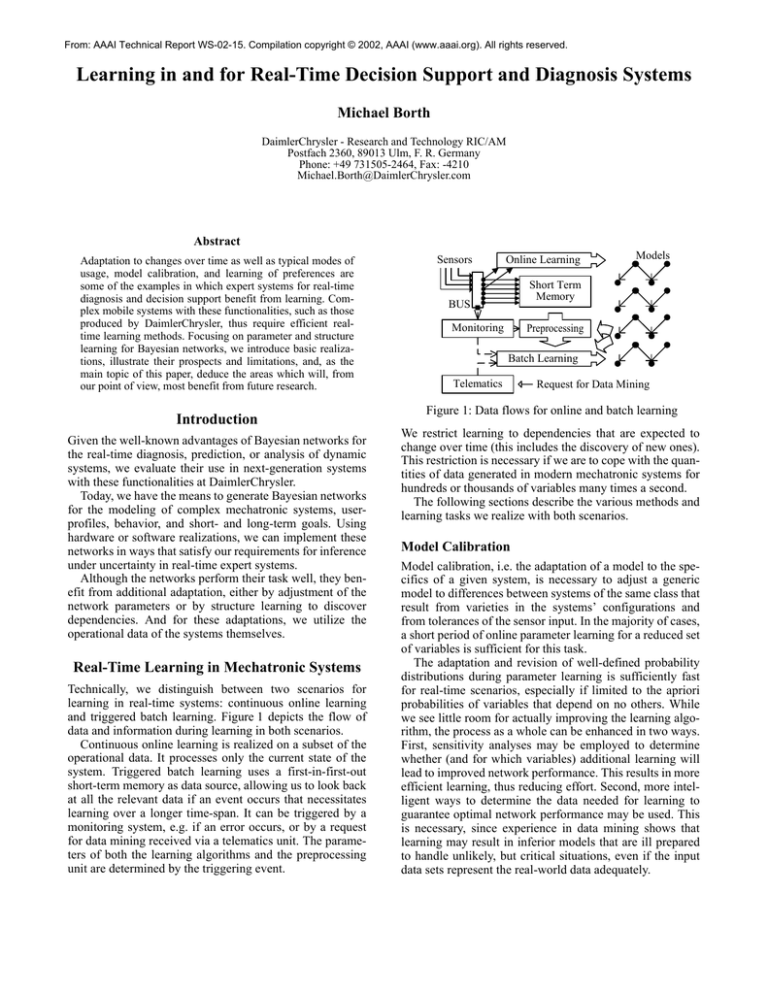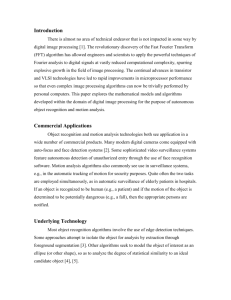
From: AAAI Technical Report WS-02-15. Compilation copyright © 2002, AAAI (www.aaai.org). All rights reserved.
Learning in and for Real-Time Decision Support and Diagnosis Systems
Michael Borth
DaimlerChrysler - Research and Technology RIC/AM
Postfach 2360, 89013 Ulm, F. R. Germany
Phone: +49 731505-2464, Fax: -4210
Michael.Borth@DaimlerChrysler.com
Abstract
Adaptation to changes over time as well as typical modes of
usage, model calibration, and learning of preferences are
some of the examples in which expert systems for real-time
diagnosis and decision support benefit from learning. Complex mobile systems with these functionalities, such as those
produced by DaimlerChrysler, thus require efficient realtime learning methods. Focusing on parameter and structure
learning for Bayesian networks, we introduce basic realizations, illustrate their prospects and limitations, and, as the
main topic of this paper, deduce the areas which will, from
our point of view, most benefit from future research.
Introduction
Given the well-known advantages of Bayesian networks for
the real-time diagnosis, prediction, or analysis of dynamic
systems, we evaluate their use in next-generation systems
with these functionalities at DaimlerChrysler.
Today, we have the means to generate Bayesian networks
for the modeling of complex mechatronic systems, userprofiles, behavior, and short- and long-term goals. Using
hardware or software realizations, we can implement these
networks in ways that satisfy our requirements for inference
under uncertainty in real-time expert systems.
Although the networks perform their task well, they benefit from additional adaptation, either by adjustment of the
network parameters or by structure learning to discover
dependencies. And for these adaptations, we utilize the
operational data of the systems themselves.
Real-Time Learning in Mechatronic Systems
Technically, we distinguish between two scenarios for
learning in real-time systems: continuous online learning
and triggered batch learning. Figure 1 depicts the flow of
data and information during learning in both scenarios.
Continuous online learning is realized on a subset of the
operational data. It processes only the current state of the
system. Triggered batch learning uses a first-in-first-out
short-term memory as data source, allowing us to look back
at all the relevant data if an event occurs that necessitates
learning over a longer time-span. It can be triggered by a
monitoring system, e.g. if an error occurs, or by a request
for data mining received via a telematics unit. The parameters of both the learning algorithms and the preprocessing
unit are determined by the triggering event.
Sensors
Online Learning
Models
Short Term
Memory
BUS
Monitoring
Preprocessing
Batch Learning
Telematics
Request for Data Mining
Figure 1: Data flows for online and batch learning
We restrict learning to dependencies that are expected to
change over time (this includes the discovery of new ones).
This restriction is necessary if we are to cope with the quantities of data generated in modern mechatronic systems for
hundreds or thousands of variables many times a second.
The following sections describe the various methods and
learning tasks we realize with both scenarios.
Model Calibration
Model calibration, i.e. the adaptation of a model to the specifics of a given system, is necessary to adjust a generic
model to differences between systems of the same class that
result from varieties in the systems’ configurations and
from tolerances of the sensor input. In the majority of cases,
a short period of online parameter learning for a reduced set
of variables is sufficient for this task.
The adaptation and revision of well-defined probability
distributions during parameter learning is sufficiently fast
for real-time scenarios, especially if limited to the apriori
probabilities of variables that depend on no others. While
we see little room for actually improving the learning algorithm, the process as a whole can be enhanced in two ways.
First, sensitivity analyses may be employed to determine
whether (and for which variables) additional learning will
lead to improved network performance. This results in more
efficient learning, thus reducing effort. Second, more intelligent ways to determine the data needed for learning to
guarantee optimal network performance may be used. This
is necessary, since experience in data mining shows that
learning may result in inferior models that are ill prepared
to handle unlikely, but critical situations, even if the input
data sets represent the real-world data adequately.
Adaptation to Changes over Time
The second and more complicated learning task for online
learning is the adaptation of the Bayesian networks to
changes over time. For example, the likelihood of defects is
influenced by component wearout, which in turn depends
on usage statistics and aging. Usage statistics and similar
factors are accumulations of observable evidence whose
real-time processing poses no challenge. Component wearout, however, is an example for a class of variables that
while not observable, are critical for diagnosis. In addition,
influencing factors, e.g. operational temperature, may be
unobservable or even unknown. Thus, our task here is
parameter learning with hidden variables.
State-of-the-art algorithms allow for real-time learning,
given the computational power required by the high complexity. Yet, we have to balance the advantages against the
costs incurred. In the near future, we expect such computations to remain restricted to high-end systems and key functions. While we do not anticipate significant improvements
of the algorithms in comparison to the increasing computer
performance, the latter will enable us to use these methods
where needed in the future.
Learning from Infrequent Events
Learning from infrequent events and other tasks necessitates
the discovery of previously unknown dependencies between
variables, possibly even over multiple time-steps. For example, the discovery of influence factors for temporal faults
that occur only infrequently requires learning that they only
happen under specific circumstances and often depend on
the recent state history of the system. It is not known in
advance which variables describe (or hint of) such circumstances. Another example is learning of user-preferences in
atypical situations in which a user expects support from an
assistance systems, because (s)he (and thus also the expert
system) is unfamiliar with the situation.
However, we do not perceive that present algorithms for
the resulting task of structural learning with hidden variables are sufficiently fast for real-time online learning targetting at all potentially relevant variables. Instead, we
initiate a batch learning process if a trigger event occurs.
This process learns a model about the current situation and
its history. The model is then refined whenever a similar
trigger event occurs. Over time, we may or may not learn
what is typical about the situation. This approach, as any
other, is not guaranteed to solve the issue that the interesting
learning examples are very sparse, or, more formally, that
we face a highly unbalanced class distribution - and thus a
difficult learning task even without real-time constraints.
Feedback of Model Information into Learning
The more complex of our learning tasks require the processing of information encoded in the Bayesian networks in
addition to the input from sensor data. This feedback of
model information into learning differs from standard input:
Not evidence, i.e. information that a variable has a certain
value, but probability distributions, in certain circumstances
even information about the existence of dependencies, form
the input. Additional mechanisms to control the learning
process are a partial solution for such situation, but an adaptation of the learning algorithms is also necessary. Learning
of a model with attention to the current state of the model is
not restricted to real-time scenarios, but we consider it especially important not to disregard the high-level information
available in the networks under such constraints.
Conclusion and Further Research
The learning tasks we encounter at DaimlerChrysler cover a
wide range of real-world applications. They are not
restricted to our field of expertise and solutions should be
transferable to other areas without much effort. Therefore,
we hope that this paper will initiate a fruitful discussion and
additional research on the topics we have illustrated.
With today’s algorithms for inference and parameter
learning, we consider Bayesian networks to be a sensible
choice for self-adapting expert systems. Improvements of
the algorithms are welcome - and sometimes necessary. But
given the underlying complexity of the adaptation tasks, we
do not expect any breakthroughs. Instead, we have to look
at methods to optimize the algorithms for hardware realizations. Today, dependable and affordable solutions exist for
inference. As a first step, we need to extend them to learning in fixed situations. Later, we have to add the flexibility
needed to cope with the continuously changing situations
and tasks we face for modern mobile systems.
Additionally, the network compilation requires further
research: modern network compilers use heuristics to transform networks into an 'efficient' structure. However, it is
seldom taken into account that definitions of efficiency
depend on the context. For example, smaller structures are
needed for hardware realizations of common components
(they are cheaper), but, for critical control systems, this may
not matter in comparison to speed. Thus, we believe that the
industrial implementation of Bayesian networks will benefit
from the development of open compiler systems which
allow for an optimization of networks to specific requirements, from design guidelines specifying the best practice
for common goals, and case studies, which describe efforts
and benefits of such optimizations.
Further on, real-time machine learning reconfirms a data
mining lesson: an intelligent approach, based on domain
knowledge and understanding of machine learning that consists not only of modeling but also of business and data
understanding, data preparation, and model deployment, is
more valuable with respect to the quality of results than
improvements of algorithms will ever be.
Acknowledgements
This paper describes work of the author and several other
researchers at DaimlerChrysler. Special acknowledgements
go to Rüdiger Wirth (Research Machine Learning and
Information Mining), Hermann von Hasseln (Research
Electronics and Mechatronics), and Harald Renninger
(Research Electrics/Electronics Architecture & Diagnosis).






